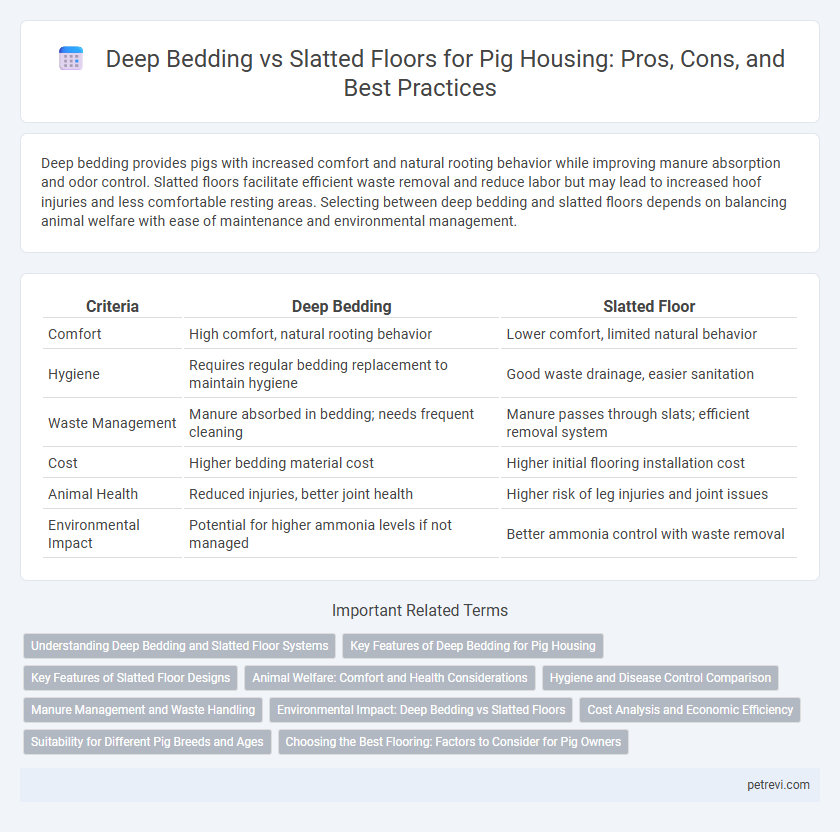Deep bedding provides pigs with increased comfort and natural rooting behavior while improving manure absorption and odor control. Slatted floors facilitate efficient waste removal and reduce labor but may lead to increased hoof injuries and less comfortable resting areas. Selecting between deep bedding and slatted floors depends on balancing animal welfare with ease of maintenance and environmental management.
Table of Comparison
| Criteria | Deep Bedding | Slatted Floor |
|---|---|---|
| Comfort | High comfort, natural rooting behavior | Lower comfort, limited natural behavior |
| Hygiene | Requires regular bedding replacement to maintain hygiene | Good waste drainage, easier sanitation |
| Waste Management | Manure absorbed in bedding; needs frequent cleaning | Manure passes through slats; efficient removal system |
| Cost | Higher bedding material cost | Higher initial flooring installation cost |
| Animal Health | Reduced injuries, better joint health | Higher risk of leg injuries and joint issues |
| Environmental Impact | Potential for higher ammonia levels if not managed | Better ammonia control with waste removal |
Understanding Deep Bedding and Slatted Floor Systems
Deep bedding systems for pig housing utilize thick layers of materials such as straw or wood shavings, which absorb moisture and provide insulation, promoting animal comfort and reducing stress. Slatted floor systems feature perforated surfaces, allowing waste to fall through into storage pits below, improving hygiene by minimizing direct contact with manure. Understanding the moisture management, ease of cleaning, and animal welfare implications of these systems is essential for optimizing pig housing design.
Key Features of Deep Bedding for Pig Housing
Deep bedding for pig housing utilizes materials like straw or sawdust, which provide enhanced comfort and insulation, promoting natural behaviors such as rooting and nest-building. This system improves manure absorption, reducing ammonia emissions and maintaining better air quality compared to slatted floors. Deep bedding also supports animal welfare by offering cushioning that minimizes injuries and stress, leading to healthier and more productive pigs.
Key Features of Slatted Floor Designs
Slatted floor designs in pig housing feature sturdy, non-slip surfaces with adequately spaced slats to allow efficient waste drainage, improving hygiene and reducing labor in manure management. Typically constructed from concrete or durable plastic, these floors support proper ventilation and minimize contact with waste, helping to control odors and prevent disease spread. Key considerations include slat width and thickness, load-bearing capacity, and ease of cleaning to ensure pig comfort and maintain optimal barn conditions.
Animal Welfare: Comfort and Health Considerations
Deep bedding provides enhanced comfort and insulation for pigs, reducing stress and promoting natural behaviors such as rooting and nest building, which are crucial for animal welfare. In contrast, slatted floors facilitate efficient waste removal but may cause discomfort and increase the risk of joint injuries or hoof problems, impacting long-term health. Optimal pig housing balances clean, dry environments with comfortable surfaces to support both physical health and behavioral needs.
Hygiene and Disease Control Comparison
Deep bedding in pig housing promotes better hygiene by absorbing moisture and reducing ammonia levels, which minimizes pathogen growth and respiratory issues. Slatted floors allow for efficient waste removal but may increase the risk of localized infections due to incomplete manure drainage and pig contact with feces. Effective disease control depends on regular maintenance, with deep bedding requiring frequent replacement to prevent bacterial buildup, while slatted floors demand consistent slurry management to maintain sanitary conditions.
Manure Management and Waste Handling
Deep bedding systems in pig housing improve manure management by absorbing moisture, reducing odor, and facilitating composting, which converts waste into valuable fertilizer. Slatted floors allow manure to drop directly into a pit or slurry system, enabling efficient waste removal but requiring regular maintenance to prevent blockages and ammonia buildup. Both methods impact environmental control and labor demand, with deep bedding favoring natural waste processing and slatted floors supporting mechanical manure handling.
Environmental Impact: Deep Bedding vs Slatted Floors
Deep bedding systems in pig housing significantly improve manure management by promoting aerobic decomposition, which reduces methane emissions compared to slatted floors that often lead to anaerobic conditions and higher greenhouse gas output. They enhance nutrient recycling by allowing organic matter to break down naturally, enriching soil quality when manure is used as fertilizer. In contrast, slatted floors concentrate waste in lagoons that may cause odor issues and potential water pollution due to nutrient runoff.
Cost Analysis and Economic Efficiency
Deep bedding systems for pig housing typically involve higher initial costs due to material procurement and regular replacement but can reduce long-term expenses by improving animal welfare and reducing veterinary bills. Slatted floors demand lower upfront investment and facilitate easier manure management, which decreases labor costs and enhances biosecurity. Economic efficiency depends on balancing these factors with productivity gains, where deep bedding may offer higher returns through better growth rates and meat quality despite increased maintenance expenses.
Suitability for Different Pig Breeds and Ages
Deep bedding systems offer enhanced comfort and insulation, making them ideal for sow and piglet housing where warmth and nesting behavior are crucial; breeds with higher activity levels benefit from the softer, more absorbent flooring. Slatted floors are better suited for grower-finisher pigs and heavier breeds as they facilitate efficient waste management and maintain hygiene but may cause discomfort for younger or lighter pigs due to less cushioning. Selecting the optimal flooring depends on the pig's breed-specific behaviors and age-related needs, balancing welfare with operational efficiency.
Choosing the Best Flooring: Factors to Consider for Pig Owners
Deep bedding systems provide pigs with enhanced comfort, better insulation, and promote natural behaviors, which can improve welfare and reduce stress levels. Slatted floors facilitate efficient waste management and improve hygiene by allowing manure to fall through gaps, but may be less comfortable for pigs and increase the risk of injuries. Pig owners must weigh factors such as animal welfare, maintenance costs, manure handling efficiency, and flooring durability when selecting between deep bedding and slatted floor systems.
Deep Bedding vs Slatted Floor for Pig Housing Infographic

 petrevi.com
petrevi.com